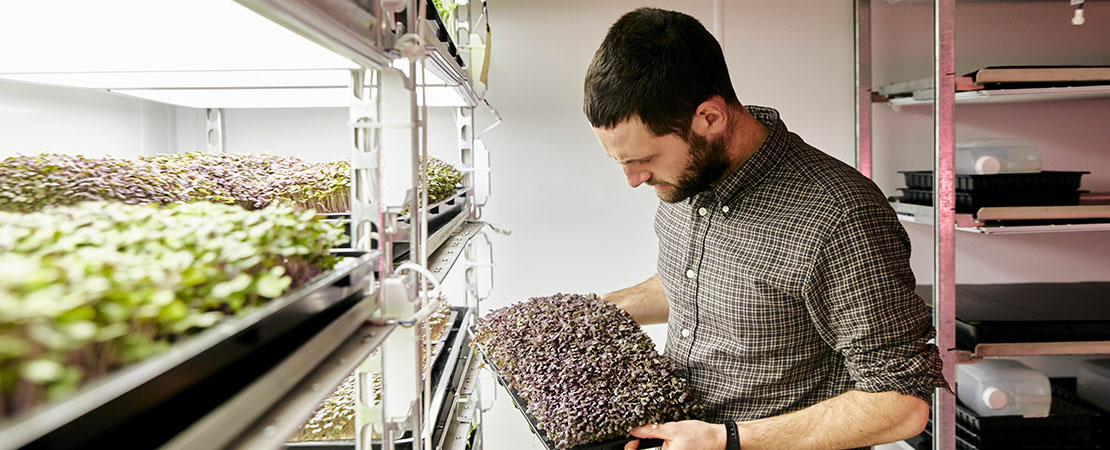Vertical Cannabis Farming: The Future Of Cannabis Cultivation
Vertical cannabis farming is a profitable way to increase your grow facility’s capacity and thus expand your business.
Indoor cannabis farming has traditionally been done on horizontal farms with the help of complex lighting and ventilation systems. However, over time, there’s been an increased demand for efficiency and sustainability in indoor cannabis growing.
Vertical cannabis farming is an intelligent cultivation setup that boosts yield through increased efficiency.
The major hurdle with growing cannabis indoors is managing space to maximize the grow space capacity.
The more plants you can grow and harvest within a year, the more gains you will make from your grow op.
Vertical farming is a method of growing cannabis indoors that leverages Controlled environment agriculture (CEA) technology to produce high-quality cannabis year-round.
This farming method is rising in popularity and is increasingly being accepted as a profitable way to maximize an indoor grow output.
What Is Vertical Cannabis Farming?
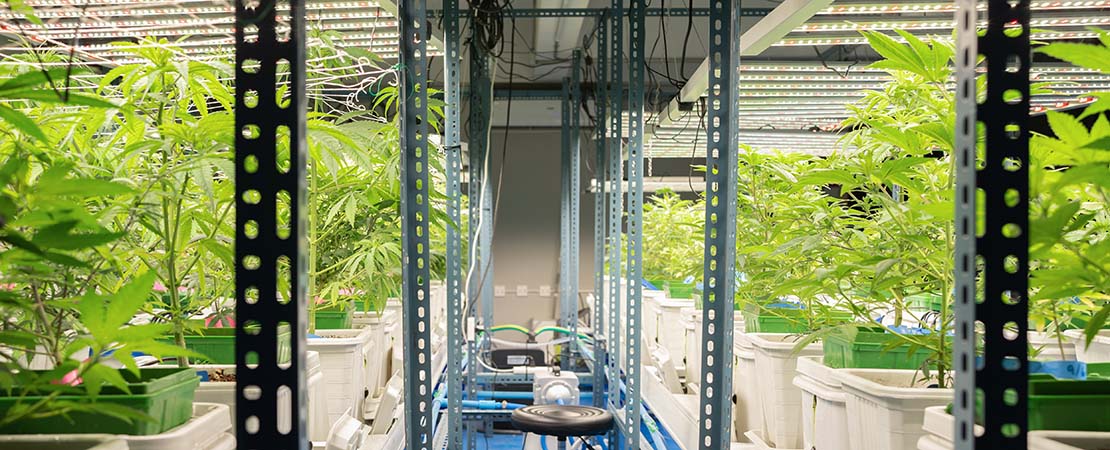
Vertical cannabis farming is the practice of growing cannabis in vertically stacked layers.
Vertical farming rides on CEA technology for its success. CEA is an intensive form of hydroponically- based agriculture where the cannabis grows within a controlled environment.
Hydroponics is the cultivation of plants in nutrient-enriched water, which uses 98% less water than traditional cultivation methods.
Vertical farming is essentially a technology-based approach to farming.
It entails using technologies such as HVACs, ACs, lighting, and irrigation systems to artificially create climatic conditions that allow plants to grow. These systems regulate the humidity, temperature, CO2 levels, and light the plants require for maximum yield.
Adopting the farming method has resulted in some significant advancements in indoor cannabis farming.
One of those advancements includes the shift from using HPS grow lights to using LED lights in growing cannabis plants.
HPS lights emit much more heat, which could scorch and damage the plants. LED lights became preferable for indoor cultivation, especially in vertical farming. The LED lights produce less heat facilitating the proximity between lights and plants common with using vertical systems.
Other key innovations like the mezzanine walkway improve worker productivity and safety as they reach for plants higher up in the vertical systems.
Types of Cannabis Vertical Farming
There are different approaches to growing cannabis vertically. The cannabis plants can be planted on shelves, columns, or walls. All of which are divided into two categories.
1. Stacked Vertical
Stacked vertical grow is simply one horizontal farm on top of another.
The lights can run through the top of each stacked tier. In addition, the irrigation systems run through the hydroponic trays that house the grow medium for the cannabis plants.
On the other hand, the shelvings can be arranged in a square formation around a central light source.
The key to a successful stacked vertical cannabis grow is keeping the plants short. You can consider growing the auto-flowering cannabis varieties. They grow fast and are easy to manage, even for a beginner.
2. True Vertical
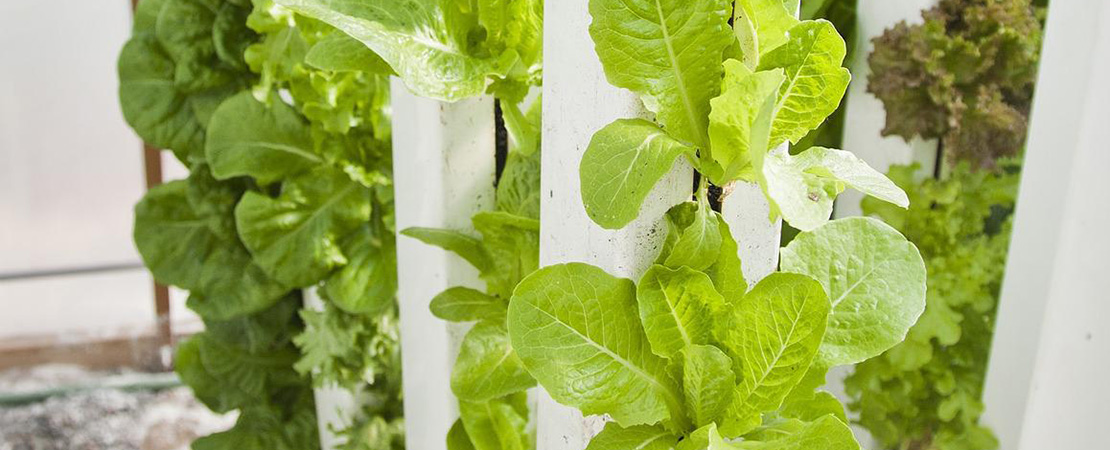
With true vertical grow, the plants grow out the side of a column.
The method employs the nutrient film technique (NFT) and aeroponics to provide nutrients and water to the cannabis plants.
Aeroponics is a soilless growing method where the roots are exposed to air, then NFT incorporated, where nutrient water is passed directly over the roots.
Advantages and Disadvantages of Vertical Cannabis Farming
As with every other cultivation method, vertical cannabis farming has merits and demerits.
As a prospective vertical cannabis farmer, you need to assess your target for the grow space and, from that basis, create a model that works for your operation.
Advantages of Vertical Cannabis Farming
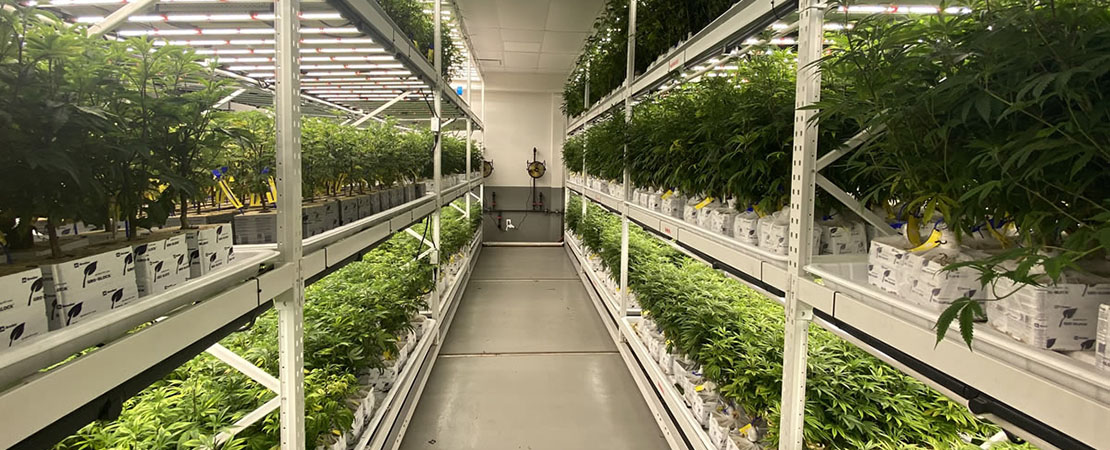
1. Reliable Year-Round Cannabis Production
Vertical farming is not dependent on weather. This means you can have consistent year-round crop production without worrying about adverse weather conditions affecting the quality of your yields.
In addition, vertical farming incorporates automation allowing for repeatable programmable production. Therefore, you can meet customer demand with the increased acreage while maintaining high-quality flavor and potency.
2. Optimal Use of Space
In traditional farming, you need several acres of fertile land to produce high cannabis yields.
However, with vertical farming stacking technology, you can expand the available acreage by three or more times.
Using technologies like vertical grow racks, you can use your warehouse’s overhead space to grow more cannabis canopies.
Vertical grow racks are made of steel, enabling them to carry the weight of your canopies and irrigation systems. Furthermore, the rebars used to support your grow trays make it simple and seamless to integrate your lighting systems.
We do, also, have mobile carriages. These are completely rust-proof systems propelled by heavy-duty flange wheels and bar tracks.
The flange wheels are secure and fit snugly on our rigged bar tracks, eliminating the possibility of racking or tipping. As a result, your valuable cargo is safe and able to be moved with ease.
Furthermore, the mobile carriage vertical systems bar rack is strong enough to support multiple tiers.
These systems are unique in that they are customized to fit the space to the maximum capacity.
3. Low Labor Costs and Enhanced Worker Safety

Vertical systems are designed with worker safety and efficiency in mind.
Configuring your vertical cannabis farm with an automated growing system eliminates some of the labor demand on your business.
The automated systems irrigate your plants, fertilize, and regulate the humidity, temperature, and lighting. This ensures consistency in your yields and allows your workers to only focus on inspecting and harvesting your cannabis canopies.
Vertical farming has low labor overhead costs, allowing you to scale without incurring additional costs.
Moreover, indoor farming protects workers from the hazards of heavy farming machinery and exposure to harmful farm chemicals.
Vertical farming is an approach that boasts of using low agricultural chemicals like herbicides and pesticides as the enclosed system reduces the chances of the plants being contaminated.
Disadvantages of Vertical Cannabis Farming

1. Technology Dependent
For a farmer to maintain the required climatic conditions for cannabis to grow, they have to utilize various equipment such as grow lights, HVACs, and CO2 burners.
Any hitch with these technologies can be detrimental to the health of your plants and, as a result, impact your bottom line.
Therefore, regular maintenance of your equipment is critical to ensuring maximum output. Also, it’s crucial to have backup power to ensure your systems are always operational.
2. High Startup Costs
At the onset of growing cannabis indoors, purchasing quality grow equipment can increase startup costs. There’s a demand to acquire advanced climate control systems, vertical grow racks, and sensors, which aren’t cheap.
However, in the long-run vertical growing of cannabis proves cost-effective as there’s no need for additional adjustments than starting with horizontal farms and then transitioning.
Start Your Vertical Cannabis Farming Op Today
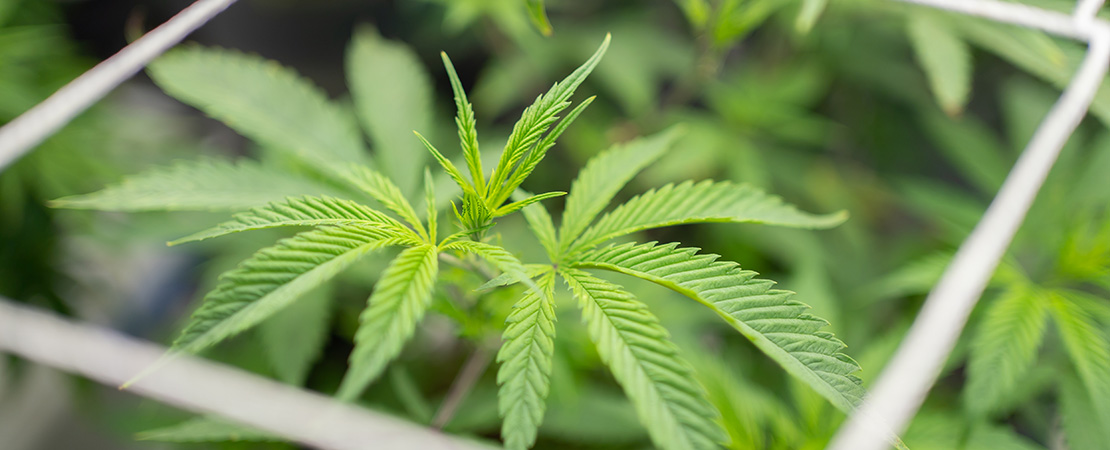
Vertical cannabis farming is a popular cultivation method helping revolutionize the industry. It’s a technology-based practice that boosts acreage per square foot by utilizing vertical grow racks with multiple shelving.
Thanks to advancements in the industry, farmers can now plant all year regardless of climatic conditions, increasing their profits.
MMI Agriculture is a vertical systems specialist company that installs vertical systems for cannabis cultivators. Whatever type of indoor space you have (warehouse or skyscraper), we have a professional team to help you design and install our cutting-edge vertical systems.
So, are you planning to begin or transition into vertical cannabis farming? Contact us today.

